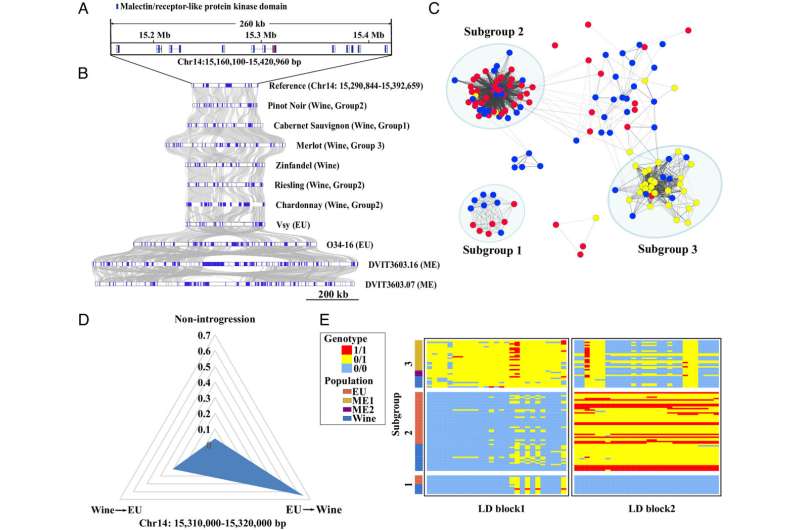June 8, 2023 report
This article has been reviewed according to Science X's editorial process and policies. Editors have highlighted the following attributes while ensuring the content's credibility:
fact-checked
peer-reviewed publication
trusted source
proofread
As expected, wine grapes found to have high deleterious genetic burden

Researchers at the Chinese Academy of Agricultural Sciences, China, have applied machine learning to genetic sequence data from wild and domestic European grapes.
In the study, "Adaptive and maladaptive introgression in grapevine domestication," published in PNAS, the researchers investigated the history of genetic hybridization between domesticated grapes and their European wild relatives, tracing the origin back to a single domestication event in wine grapes.
According to the study authors, domesticated grapevines spread to Europe around 3,000 years ago. Archaeological evidence dates the first domestication of grapevines to around 5,900 BC, with the propagation sylvestris varieties in the South Caucasus, the northern Fertile Crescent, and the Levant.
After their domestication, grapes were spread throughout the Mediterranean world, diversifying into many locally adapted varieties. Within the last 3,000 years, grapevines were established in Europe, where the imported varieties came into contact with genetically distinct wild sylvestris populations.
Certain gene regions of the wine grapes related to aromatic compound synthesis were enriched with wild versions, suggesting that European wild grapes have been an essential resource for improving the flavor of wine grapes.
The team collected existing sequencing data from 305 samples and performed sequencing on 40 samples from the USDA grape germplasm collections in Davis, California using the Illumina HiSeq 4000 platform. The combined collection covered a wide distributional range of global wild and cultivated grapes.
Machine learning–based population genetic analysis detected evidence for a single domestication event of a grapevine, followed by continuous gene flow between European wild grapes (EU) and cultivated grapes over the past ~2,000 years.
Throughout hybridization events and intentional breeding improvements, genetic fragments have been introduced with a higher deleterious burden, with most deleterious single nucleotide polymorphisms (SNPs) and structural variants hidden in a heterozygous state.
The authors suggest that the beneficial effects of hybridization carry a potential cost as certain regions have elevated numbers of known deleterious variants. The identification of beneficial and deleterious variants could be important factors for a more genomic-based strategy of breeding grapevines.
How deleterious?
The suggestion of deleterious burden is based on segments of DNA that are not specifically advantageous, usually non-coding and something typically eliminated in wild plants by natural selection.
It is worth pointing out that deleterious burden can be found in any domesticated plant variety: Potatoes, tomatoes, rice, soy and maize all have a lot of extra genomic components that natural selection has not removed because of human breeding. While it may be possible to engineer plant genomes to have less deleterious burdens, it is unclear if this would have any positive effect on the resulting plant as these regions are typically inactive.
Having regions that are not crucial to the function of any organism could even be an advantage. If a random mutation takes place in a critical gene, the downstream effect would be deleterious to the organism. If that same random mutation occurs in a deleterious burden gene, the outcome would be less deleterious to the organism. Around 98% of the human genome is non-coding, and while not all "junk DNA" is completely useless, it is a comfortable buffer against the truly deleterious effects of random mutations that alter coding genes.
Table grapes were also looked at in the study. These varieties were found to have 100 times lower hybridization events, suggesting that while wine grapes have gone through intensive crop improvement, the table grape has been perfect all along.
More information: Hua Xiao et al, Adaptive and maladaptive introgression in grapevine domestication, Proceedings of the National Academy of Sciences (2023). DOI: 10.1073/pnas.2222041120
Journal information: Proceedings of the National Academy of Sciences
© 2023 Science X Network




















